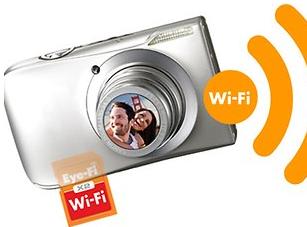Can a user take quality photos better than those snapped by smartphones, yet still upload and share them instantly to the web or social networks?

It's a question asked not only by consumers but by professional photographers wanting to immediately transmit high-quality snaps from the field. We've seen in market a new wave of WiFi-connected cameras such as Samsung's Galaxy Camera and Nikon's S800C that offer better-than-smartphone picture quality and internet connectivity.
But there's a much older way to wirelessly link cameras with the internet that has received an upgrade - the Eye-Fi SD card. It now offers more storage, faster uploading and extra features such as geotagging.
At first glance, an Eye-Fi card looks nothing more than a brightly-orange coloured SD card. But looks deceive.
The Eye-Fi SD card actually is an incredibly ingenious device, which also contains a radio-on-a-chip for mobile component, a flash memory controller, a step-down switching voltage regulator and, with the most recent modules, GPS capabilities. It's an incredibly intelligent device. You place an Eye-Fi card in your camera's SD card slot, and suddenly it's capable of not only storing photos but also transmitting them across the internet with geotagging supplied by the card - all for around $90-$125, depending on where you buy it and the version you choose.
We have been trialling the Eye-Fi Pro X2 8GB SDHC memory card, a pro version, which you can buy online locally for $90, or through major Australian retailers and camera shops.
The first thing to note is that it's an SDHC card. Many old cameras can't use SDHC cards and are restricted to using plain SD cards with capacities under four gigabytes or less. Fortunately the Eye-Fi site has a comprehensive listing of cameras and their compatibility so you can check whether a card will work with your camera before you buy.
If you go ahead and purchase an Eye-Fi, you'll notice the package contains not only the card, but also a card reader, which you use to connect your Eye-Fi card to a Windows PC or a Mac through a USB port.
You first need to configure the Eye-Fi and this, surprisingly, is a little complicated.
To start, you plug the SD card into the Eye-Fi reader and attach that to a computer's USB port. You then navigate to the "start here" folder on the card to initiate Windows PC or OS X installation.
The Eye-Fi Installer downloads the latest software and does the installation.
Running the installed software launches the Eye-Fi centre, which is where you configure the card's behaviour.
The Eye-Fi card connects a camera to a computer, iOS or Android device in a number of ways. Using the software, you can nominate WiFi networks where the Eye-Fi card can directly communicate with a mobile device on the same network.
You can set up Direct Mode to be used in the absence of WiFi-networks - the SD card's radio initiates its own WiFi network, which the mobile device attaches to for receiving photos and videos.
You can also program the card to connect to WiFi hotspots and open networks.
There are other settings. On this particular card, you can switch to uploading RAW files and nominate one of more than 25 social networks where photos can be uploaded automatically. They include Facebook, Evernote, Flickr, Shutterfly and Snapfish. But uploading files to social networks as well as a mobile device can increase your overall upload time, so beware. You can switch automatic video upload on or off, which is handy as we found video upload to be slow.
A 30-second movie on our Canon EOS M took more than two minutes to upload in direct mode to our iPhone.
Another problem is file format. The Eye-Fi card switched video upload off itself after discovering that the particular .MOV files on the Canon EOS camera couldn't play on the receiving iPhone.
It is therefore important to do some dry runs of photo and video uploads to iron out compatibility issues before taking your SD card-fitted camera and mobile phone out and about.
Nevertheless for the iPhone, the Eye-Fi card delivers the photos straight to the camera roll from where you can share your photos in the usual Apple way. Uploaded photos also go to Photo Stream.
But once you have the card properly configured and in your camera, the process of automatically uploading photos works wonderfully well.
After taking snaps, you must ensure that your camera stays on long enough to complete uploading all photos and video before it goes into sleep mode.
Many modern cameras let you adjust power settings - some like our Canon EOS M have their own Eye-Fi configuration options in their menu, which lets you switch the WiFi capability on and off and invoke suitable power settings.
Having just 8GB on an SD card might sound limiting.
However, the Eye-Fi has an endless memory mode where the card deletes old content that already has been uploaded. You set a memory threshold for the feature to kick in.
You can also buy a subscription to Eye-Fi's unlimited cloud storage feature.
All in all, the Eye-Fi is a remarkable device, but configuration does take time and you'll need to give yourself time to learn its capabilities. The pro versions are available online and in stores for $90-$120.





